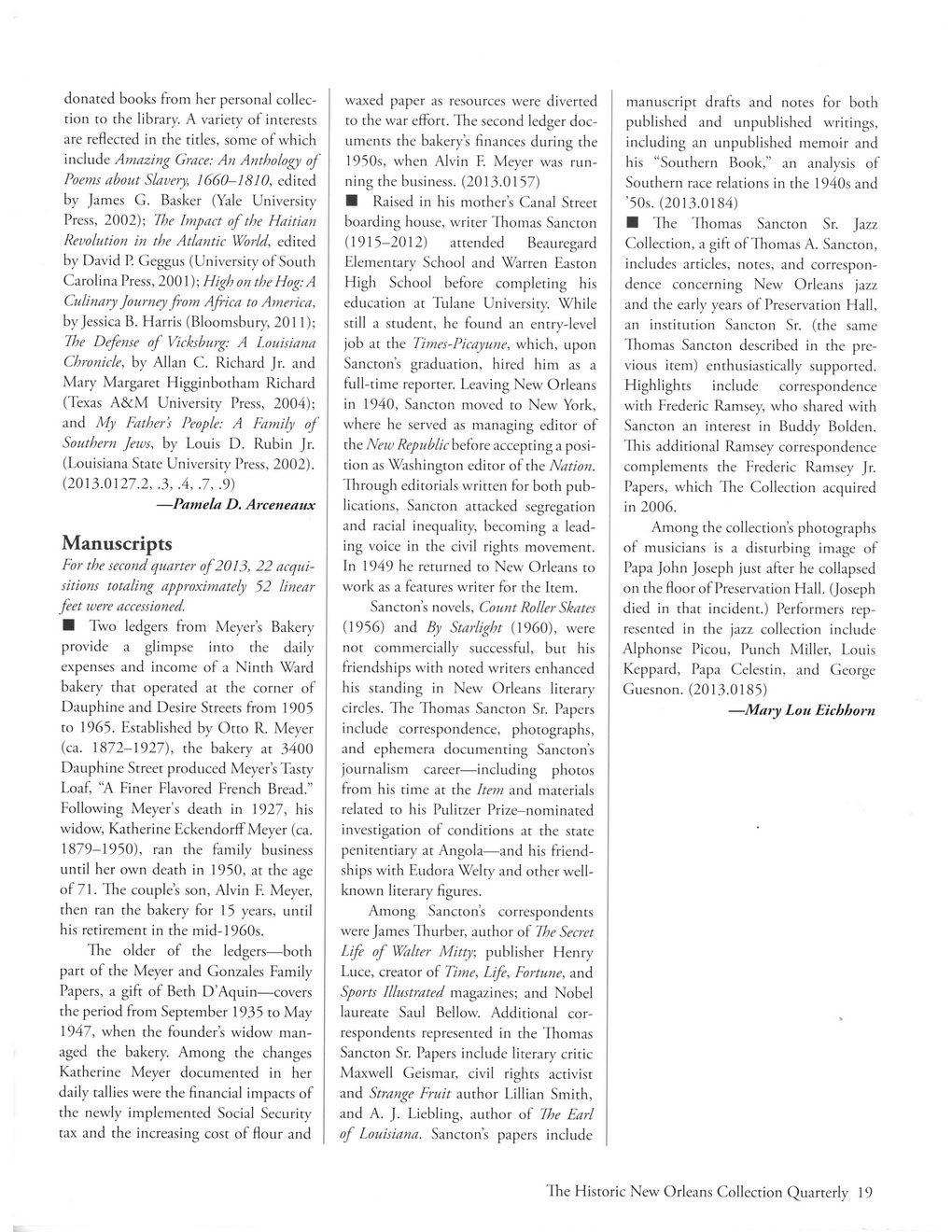This text was obtained via automated optical character recognition.
It has not been edited and may therefore contain several errors.
donated books from her personal collection to the library. A variety of interests are reflected in the titles, some of which include Amazing Grace: An Anthology of Poems about Slavery, 1660—1810, edited by James G. Basker (Yale University Press, 2002); The Impact of the Haitian Revolution in the Atlantic World, edited by David P. Geggus (University of South Carolina Press, 2001); High on the Hog: A Culinary Journey from Africa to America, by Jessica B. Harris (Bloomsbury, 2011); The Defense of Vicksburg: A Louisiana Chronicle, by Allan C. Richard Jr. and Mary Margaret Higginbotham Richard (Texas A&M University Press, 2004); and My Father’s People: A Family of Southern Jews, by Louis D. Rubin Jr. (Louisiana State University Press, 2002). (2013.0127.2, .3, .4, .7, .9) —Pamela D. Arceneaux Manuscripts For the second quarter of2013, 22 acquisitions totaling approximately 52 linear feet were accessioned. ■ Two ledgers from Meyer’s Bakery provide a glimpse into the daily expenses and income of a Ninth Ward bakery that operated at the corner of Dauphine and Desire Streets from 1905 to 1965. Established by Otto R. Meyer (ca. 1872-1927), the bakery at 3400 Dauphine Street produced Meyer’s Tasty Loaf, “A Finer Flavored French Bread.” Following Meyer's death in 1927, his widow, Katherine Eckendorff Meyer (ca. 1879-1950), ran the family business until her own death in 1950, at the age of 71. The couple’s son, Alvin F. Meyer, then ran the bakery for 15 years, until his retirement in the mid-1960s. The older of the ledgers—both part of the Meyer and Gonzales Family Papers, a gift of Beth D’Aquin—covers the period from September 1935 to May 1947, when the founder’s widow managed the bakery. Among the changes Katherine Meyer documented in her daily tallies were the financial impacts of the newly implemented Social Security tax and the increasing cost of flour and waxed paper as resources were diverted to the war effort. The second ledger documents the bakery’s finances during the 1950s, when Alvin F. Meyer was running the business. (2013.0157) I Raised in his mother’s Canal Street boarding house, writer Thomas Sancton (1915—2012) attended Beauregard Elementary School and Warren Easton High School before completing his education at Tulane University. While still a student, he found an entry-level job at the Times-Picayune, which, upon Sancton’s graduation, hired him as a full-time reporter. Leaving New Orleans in 1940, Sancton moved to New York, where he served as managing editor of the New Republic before accepting a position as Washington editor of the Nation. Through editorials written for both publications, Sancton attacked segregation and racial inequality, becoming a leading voice in the civil rights movement. In 1949 he returned to New Orleans to work as a features writer for the Item. Sancton’s novels, Count Roller Skates (1956) and By Starlight (1960), were not commercially successful, but his friendships with noted writers enhanced his standing in New Orleans literary circles. The Thomas Sancton Sr. Papers include correspondence, photographs, and ephemera documenting Sancton’s journalism career—including photos from his time at the Item and materials related to his Pulitzer Prize-nominated investigation of conditions at the state penitentiary at Angola—and his friendships with Eudora Welty and other well-known literary figures. Among Sancton’s correspondents were James Thurber, author of The Secret Life of Walter Mitty, publisher Henry Luce, creator of Time, Life, Fortune, and Sports Illustrated magazines; and Nobel laureate Saul Bellow. Additional correspondents represented in the Thomas Sancton Sr. Papers include literary critic Maxwell Geismar, civil rights activist and Strange Fruit author Lillian Smith, and A. J. Liebling, author of The Earl of Louisiana. Sancton’s papers include manuscript drafts and notes for both published and unpublished writings, including an unpublished memoir and his “Southern Book,” an analysis of Southern race relations in the 1940s and ’50s. (2013.0184) I The Thomas Sancton Sr. Jazz Collection, a gift of Thomas A. Sancton, includes articles, notes, and correspondence concerning New Orleans jazz and the early years of Preservation Hall, an institution Sancton Sr. (the same Thomas Sancton described in the previous item) enthusiastically supported. Highlights include correspondence with Frederic Ramsey, who shared with Sancton an interest in Buddy Bolden. This additional Ramsey correspondence complements the Frederic Ramsey Jr. Papers, which The Collection acquired in 2006. Among the collection’s photographs of musicians is a disturbing image of Papa John Joseph just after he collapsed on the floor of Preservation Hall. (Joseph died in that incident.) Performers represented in the jazz collection include Alphonse Picou, Punch Miller, Louis Keppard, Papa Celestin, and George Guesnon. (2013.0185) —Mary Lou Eichhorn The Historic New Orleans Collection Quarterly 19

New Orleans Quarterly 2013 Fall (19)